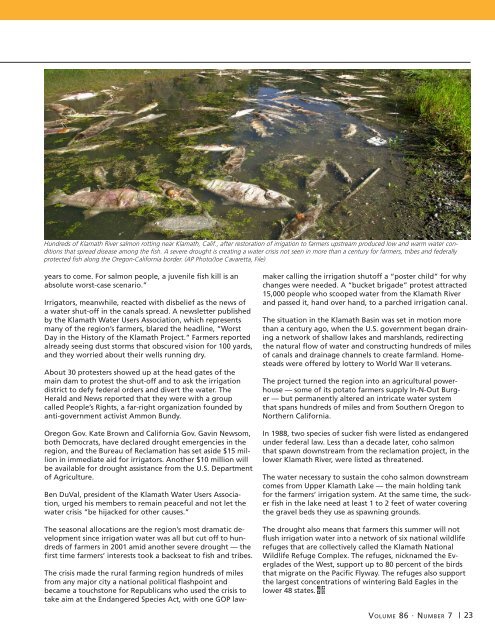CEAC-2021-07-July
Create successful ePaper yourself
Turn your PDF publications into a flip-book with our unique Google optimized e-Paper software.
Hundreds of Klamath River salmon rotting near Klamath, Calif., after restoration of irrigation to farmers upstream produced low and warm water conditions<br />
that spread disease among the fish. A severe drought is creating a water crisis not seen in more than a century for farmers, tribes and federally<br />
protected fish along the Oregon-California border. (AP Photo/Joe Cavaretta, File)<br />
years to come. For salmon people, a juvenile fish kill is an<br />
absolute worst-case scenario.”<br />
Irrigators, meanwhile, reacted with disbelief as the news of<br />
a water shut-off in the canals spread. A newsletter published<br />
by the Klamath Water Users Association, which represents<br />
many of the region’s farmers, blared the headline, “Worst<br />
Day in the History of the Klamath Project.” Farmers reported<br />
already seeing dust storms that obscured vision for 100 yards,<br />
and they worried about their wells running dry.<br />
About 30 protesters showed up at the head gates of the<br />
main dam to protest the shut-off and to ask the irrigation<br />
district to defy federal orders and divert the water. The<br />
Herald and News reported that they were with a group<br />
called People’s Rights, a far-right organization founded by<br />
anti-government activist Ammon Bundy.<br />
Oregon Gov. Kate Brown and California Gov. Gavin Newsom,<br />
both Democrats, have declared drought emergencies in the<br />
region, and the Bureau of Reclamation has set aside $15 million<br />
in immediate aid for irrigators. Another $10 million will<br />
be available for drought assistance from the U.S. Department<br />
of Agriculture.<br />
Ben DuVal, president of the Klamath Water Users Association,<br />
urged his members to remain peaceful and not let the<br />
water crisis “be hijacked for other causes.”<br />
The seasonal allocations are the region’s most dramatic development<br />
since irrigation water was all but cut off to hundreds<br />
of farmers in 2001 amid another severe drought — the<br />
first time farmers’ interests took a backseat to fish and tribes.<br />
The crisis made the rural farming region hundreds of miles<br />
from any major city a national political flashpoint and<br />
became a touchstone for Republicans who used the crisis to<br />
take aim at the Endangered Species Act, with one GOP lawmaker<br />
calling the irrigation shutoff a “poster child” for why<br />
changes were needed. A “bucket brigade” protest attracted<br />
15,000 people who scooped water from the Klamath River<br />
and passed it, hand over hand, to a parched irrigation canal.<br />
The situation in the Klamath Basin was set in motion more<br />
than a century ago, when the U.S. government began draining<br />
a network of shallow lakes and marshlands, redirecting<br />
the natural flow of water and constructing hundreds of miles<br />
of canals and drainage channels to create farmland. Homesteads<br />
were offered by lottery to World War II veterans.<br />
The project turned the region into an agricultural powerhouse<br />
— some of its potato farmers supply In-N-Out Burger<br />
— but permanently altered an intricate water system<br />
that spans hundreds of miles and from Southern Oregon to<br />
Northern California.<br />
In 1988, two species of sucker fish were listed as endangered<br />
under federal law. Less than a decade later, coho salmon<br />
that spawn downstream from the reclamation project, in the<br />
lower Klamath River, were listed as threatened.<br />
The water necessary to sustain the coho salmon downstream<br />
comes from Upper Klamath Lake — the main holding tank<br />
for the farmers’ irrigation system. At the same time, the sucker<br />
fish in the lake need at least 1 to 2 feet of water covering<br />
the gravel beds they use as spawning grounds.<br />
The drought also means that farmers this summer will not<br />
flush irrigation water into a network of six national wildlife<br />
refuges that are collectively called the Klamath National<br />
Wildlife Refuge Complex. The refuges, nicknamed the Everglades<br />
of the West, support up to 80 percent of the birds<br />
that migrate on the Pacific Flyway. The refuges also support<br />
the largest concentrations of wintering Bald Eagles in the<br />
lower 48 states.<br />
Volume 86 · Number 7 | 23


















